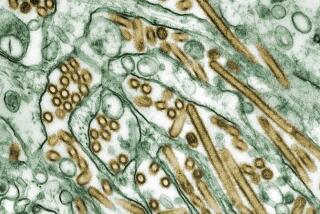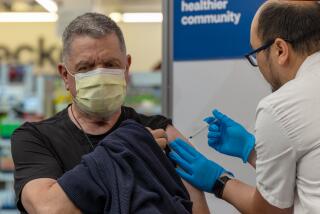Hospitals grapple with safety of scopes after UCLA outbreak

- Share via
Hospitals nationally are scrambling to figure out how to keep using a controversial medical device that benefits patients while avoiding another deadly bacterial outbreak like the one at UCLA Medical Center.
Two patients have died and five more were infected by the CRE superbug at UCLA. The hospital is also advising 179 other patients to get tested for potential exposure because they all underwent the same kind of endoscopic procedure at some time from Oct. 3 to Jan. 28.
Federal regulators aren’t pulling the devices from the market, saying that would do more harm to public health because they offer life-saving treatments that can’t be performed otherwise. Experts say a redesign of these duodenoscopes that are so hard to clean might be years away.
After 11 patients died in connection with a scope-related outbreak in Seattle, Virginia Mason Medical Center spent $1 million to buy more devices, hire extra staff and put the instruments into quarantine for 48 hours before reuse to check for any bacterial growth.
Dr. Andrew Ross, section chief of gastroenterology at Virginia Mason, said his phone has been ringing off the hook from other hospitals around the U.S. and internationally seeking advice.
“We’re in this interim period of what to do before a better mousetrap is built,” Ross said. “That’s the issue we’re grappling with nationally.”
The duodenoscopes typically involved in the outbreaks have an “elevator channel” that doctors use to bend the device in tight spaces and allow for attachments such as catheters or guide wires. The FDA warned that bacteria can build up in those tiny crevices.
“Some parts of the scopes may be extremely difficult to access and effective cleaning of all areas of the duodenoscope may not be possible,” the FDA said in a safety alert this week.
Nationally, about half a million patients each year undergo endoscopic retrograde cholangiopancreatography, or ERCP, a procedure in which doctors thread the thin device down the patient’s throat to examine and treat cancer, gallstones and other issues in the digestive system.
CRE, which stands for carbapenem-resistant Enterobacteriaceae, are germs that have become difficult to treat because they are resistant to most antibiotics.
Soeren Mattke, a senior scientist and managing director at Rand Corp., a Santa Monica-based think tank, said hospitals don’t have many choices and all of them come with drawbacks.
“It’s not easy for hospitals since the options are relatively limited,” he said.
The scopes at issue are heat sensitive so they can’t be sterilized like many other medical instruments. Instead, sterilization requires gas or liquid chemicals.
The ethylene-oxide gas can be highly toxic to employees and patients, so many hospitals phased out that capability years ago. In some cases that requires a hospital to send scopes to an outside facility, adding to the time it takes for cleaning.
UCLA moved to gas sterilization after discovering the outbreak, and it said there have been no further infections tied to the scopes since then.
“I think our procedures today would make us the safest place to come to have one of these … life-saving interventions,” Dr. David Feinberg, president of the UCLA Health System, said Thursday.
Mattke said liquid sterilization was recalled by the FDA for a time for technical reasons but it’s available now. But he said that experience left hospitals “with bad memories.”
Other hospitals are cleaning the duodenoscopes as they did before but also putting them aside for some period of time, say 48 hours, so they can test them for bacterial growth before reusing them. That can require hiring more lab staff and buying more scopes to compensate for the quarantine period.
Anxious patients want to know what hospitals are doing to keep them safe.
San Pedro resident Kimberley Miller said she’s been seriously ill since undergoing an endoscopic procedure at UCLA on Oct. 3 involving a device similar to the one at the center of the outbreak.
She called the hospital Thursday to find out whether she was among the 179 patients who may have been exposed. She reached UCLA’s top expert handling the crisis, but Miller said he didn’t rule her out from exposure.
“They wouldn’t tell me if I was on the list” of exposed patients, Miller said.
After The Times asked about her situation, Dr. Zachary Rubin, UCLA’s medical director of clinical epidemiology and infection prevention, called Miller on Friday to apologize and told her she was not exposed to CRE because her procedure used a slightly different endoscope.
“Those two scopes look almost exactly alike,” Miller said. “Were they cleaned exactly alike? I still don’t feel 100% sure.”
UCLA declined to comment on Miller or other patients, citing federal laws protecting confidentiality.
Dr. Paul M. Choi, director of the Los Angeles Endoscopy Center, said about 15 patients have called since Thursday to ask if the clinic had been affected by the CRE outbreak.
Choi said he explained his clinic doesn’t perform the ERCP procedure and doesn’t use the duodenoscopes in the FDA alert.
“Obviously, people are concerned,” he said. “People do not understand the difference between the different types of devices.”
Twitter: @chadterhune
Times staff writer Javier Panzar contributed to this report.
More to Read
Inside the business of entertainment
The Wide Shot brings you news, analysis and insights on everything from streaming wars to production — and what it all means for the future.
You may occasionally receive promotional content from the Los Angeles Times.











